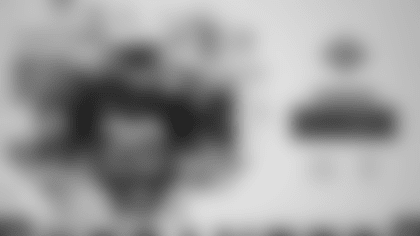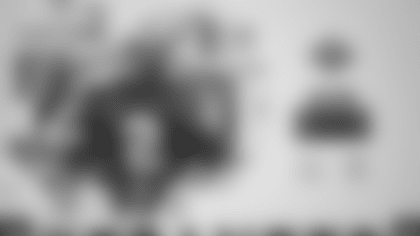The Tampa Bay Buccaneers take on the Miami Dolphins in Week Five, and we're counting down the hours to the 1:00 p.m. ET kickoff at Raymond James Stadium in Tampa. After a week of preparation, here's what it all comes down to:
5 TAMPA BAY PLAYERS TO WATCH
Richard Sherman. Sherman has already had his baptism by fire in the Buccaneers' defense, finding out last Friday that he was going to play on Sunday, on Saturday that he was going to start, and about halfway through the game on Sunday night that no subs were coming to give him a break. Four days after signing with the team, he played all but one defensive snap in the Bucs' 17-16 win over the Patriots. Sherman, who has been to five Pro Bowls and is unquestionably one of the best NFL corners of the past decade, expressed a bit of dissatisfaction with his play but also knew that was to be expected after he had been away from the game for so long. After a second week of practice, he should have a better grasp on the Bucs' defensive playbook and perhaps a bit more spring his legs as he rounds back into football shape. With Carlton Davis and Sean Murphy-Bunting on injured reserve and Jamel Dean still coming back from a knee injury, the Buccaneers will continue to lean on Sherman and his experience as they take on the Dolphins this week. Sherman has the size, length and ball skills to be a good match for Miami's best receiver, the 6-3, 216-pound DeVante Parker.
Leonard Fournette. The Buccaneers got more production out of their backfield in the win over New England than they had in any of their three previous games, and most of it was Fournette's work. The fifth-year back accounted for 139 yards from scrimmage, his best single-game total since joining the Bucs shortly before the start of the 2020 season. That included 20 carries for 91 yards, the most in both categories by any Bucs back this season, and three catches for 47 yards. The Dolphins run a defense that is similar to the Patriots' defense through former New England assistant Brian Flores, and they may choose to take the same approach, daring the Bucs to run while they focus on coverage against the NFL's top passing attack. Tampa Bay played the last game without its primary third-down back, Giovani Bernard, and Bernard was limited in practice this week, too. Fortunately, the Buccaneers also have a lot of confidence in Fournette in the passing game. "He always helps us in the pass game," said Offensive Coordinator Byron Leftwich. "Every time you look up, he has four or five catches every week – four or five big catches, really. Our [running] backs are part of our passing game all the time – getting open, doing what they need to do. They put the work in day-in and day-out throughout practice to make sure they can be an option in the passing game."
Mike Edwards. Antoine Winfield, Jr. suffered a concussion last Sunday night and was not able to exit the concussion protocol in time to suit up this weekend against the Dolphins. He has been ruled out for the game, which makes Edwards the starter at safety next to Jordan Whitehead. Last year, Edwards gained the reputation of being a ball-hawk, making the most of his somewhat limited playing by frequently getting his hands on the football. He proved that again in Week Two against the Falcons when he became just the second player in team history to record two pick-sixes in a single game. Whitehead and Edwards often share snaps while Winfield stays in for every, but their complementary talents will also work well with them starting together. Winfield is more likely to approach the line of scrimmage and make plays in run support while Edwards is more likely to play centerfield, especially when the Bucs are in a single-high coverage. Edwards is a smart and instinctive player who does best when he has his eyes on the quarterback. The Bucs will miss Winfield's playmaking – he had an interception and a forced fumble in New England – but Edwards will get a chance to show what he can do with a full plate of defensive snaps.
Cameron Brate. Like Edwards, Brate is a productive and proven backup to one of the team's key players, and he'll continue to take on a bigger role with Rob Gronkowski out for a second game with fractured ribs. With Gronkowski out last week, the Buccaneers gave quite a few more offensive snaps to both Brate (50) and O.J. Howard (51) and the offense was still able to use two and three-TE packages on 23 plays. Brate had 72 snaps through the first three games while Howard had 31. Brate has been a sure-handed weapon for the Bucs for years, racking up 230 receptions for 2,510 yards and 29 touchdowns, the lattermost of which is the fourth most in team history. Brate has always been a particularly effective weapon for Tampa Bay from the 30-yard line, and the Buccaneers are intent on getting better in that area after struggling in New England and too often settling for field goals. Where the Bucs may need Brate – and Howard, for that matter – to step up the most is on the line of scrimmage. When Brate stays in to block on passing plays he'll be contending with a Miami pass rush that is sending blitzes at a higher rate than any other defense in the league.
Shaquil Barrett. Speaking of a pass rush, the Bucs finally found one in Week Four. Even with Jason Pierre-Paul sitting out, the Bucs got a season-high four sacks and 12 quarterback hits on New England rookie Mac Jones. They succeeded most often when bringing extra rushers in terms of getting pressure overall, but two of their four sacks came on four or three-man rushes. Barrett was responsible for one of those four sacks, his second of the season, just a few days after he predicted the Buccaneers would have no more games this season with just one sack, as was the case in their first three outings. Barrett's pressure rate is down a bit this season, according to NFL Next Gen Stats, but there is plenty of time left for him to get it back up to around 15%, where it has stood the past two seasons. His 155 pressures since the start of 2019 are second in the NFL only to Aaron Donald's 173, and his 12 turnovers caused by pressure is the most in the league in that span. On Friday, Head coach Bruce Arians says "it's time" for the Buccaneers' pass rush to start dominating week-in and week-out, and it will likely be Barrett who leads the way if that happens. This week, he'll face a Miami offensive line that has been in flux all season and 24th in the league in sacks allowed per pass play.
4 STATS THAT MATTER
- 40.9%. That's the percentage of defensive snaps on which the Dolphins have blitzed through four games, according to NFL Next Gen Stats, and it's the highest rate in the NFL. This is nothing new for Brian Flores's defense; the Dolphins blitzed 40.8% of the time last season to rank second in the NFL. It's understandable that they are sticking with the strategy, because it is working; in fact, it's working even better than it did a year ago. The Dolphins' pressure rate on blitzes has gone up from 31.8% to 34.9% and their passer rating allowed has gone down from 90.3 to 84.3. However, when Flores has faced Tom Brady he has only blitzed on 20% of the QB's dropbacks and his defenses have recorded zero pressures on 12 blitzes overall.
- 19%/9.8/127.5. The Buccaneers do not use play-action as much as most teams in their passing attack, but they've had very good results when they do. Tampa Bay has run play-action on 19% of Brady's dropbacks, which is the fourth-lowest percentage in the NFL. However, on those plays Brady has averaged 9.8 yards per attempt (third in the league), with a passer rating of 127.5 (fourth).
- 3.0/4.0. Those two numbers illustrate the importance of Vita Vea in the Buccaneers' run defense, which now ranks first in the NFL after allowing a team-record -1 yards to New England last Sunday. If the Buccaneers can maintain that ranking, they'll be the first team to lead the NFL in run defense for three straight seasons since the Vikings from 2006-08. Since the start of the 2020 season and including the playoffs, the Buccaneers allow 3.0 yards per carry when Vea is on the field. They allow a full yard more, 4.0 per carry, when Vea is not on the field.
- 246/30.8%. Miami pass-catchers have not helped their quarterbacks with an abundance of yards after the catch this season. The Dolphins have a team YAC total of 246 yards, which is better only than the Chicago Bears. And Miami's percentage of passing yards that come after the catch, 30.8%, is the lowest in the entire NFL.
3 LINEUP NOTES
- As noted above, the Buccaneers will be without two more of their starting defensive backs in Week Five as both cornerback Carlton Davis (calf, placed on IR) and safety Antoine Winfield, Jr. (concussion, ruled out for Sunday) suffered new injuries against the Patriots. Richard Sherman and Pierre Desir finished that game as the team's outside cornerbacks, with Ross Cockrell in the slot, but Jamel Dean is expected to be active for Sunday's game against Miami and could factor into the starting mix.
- The Dolphins have already started four different offensive line combinations in four games, and they could have a fifth one depending upon who starts at center. With their opening-day center, Michael Deiter, on injured reserve, the Dolphins started Greg Mancz at that spot in Week four, but they have since signed veteran Austin Reiter, who has 33 career NFL starts under his belt. Reiter could get the call over Mancz. Miami might also choose to shuffle some linemen to different spots given the persistent struggles that left tackle Austin Jackson has encountered this season.
- With defensive lineman Patrick O'Connor ruled out of Sunday's game due to a calf injury, the Buccaneers will be without their most active special teams player. Through four games, O'Connor has been on the field for 91% of the team's special teams snaps. On Friday, Head Coach Bruce Arians said one option the team has considered to fill that void was activating second-year outside linebacker Cam Gill from injured reserve. Gill return to practice last week and has already missed the minimum number of three games so he is eligible to return to the active roster from injured reserve. The Bucs have an open spot on that roster after placing Carlton Davis on injured reserve on Thursday.
2 CHALLENGES PRESENTED BY THE DOLPHINS
The Miami offense is without opening-day starting quarterback Tua Tagovailoa, the fifth pick in the 2020 draft, and has yet to kick into gear, averaging just 252.0 yards per game so far. However, substitute quarterback Jacoby Brissett has plenty of experience, a career 83.5 passer rating and a career 33-14 TD-INT ratio. He also has an intriguing set of pass-catching targets in big receiver DeVante Parker, shifty rookie Jaylen Waddle and productive tight end Mike Gesicki. The Dolphins' defense has slid back a bit from its fifth-place finish in points allowed last year, giving up the eighth most points per game this year (27.3). However, Tom Brady called it a talented and well-coached group earlier this week and the Dolphins could be getting back a big space-eater up front if defensive tackle Raekwon Davis is activated from injured reserve before the game. Here is a more specific challenge on each side of the ball the Buccaneers will face on Sunday.
One week after facing one of the best cornerback duos in the NFL in New England, the Buccaneers will face a similar test on Sunday against Miami. Xavien Howard and Byron Jones are also an elite duo, and while both were limited at times in practice this week they were cleared to play on Friday's injury report. Howard led the NFL with 10 interceptions last year and has won of the Dolphins' two picks so far in 2021, and both he and Jones already have five passes defensed. Since the start of last season, Howard has allowed the second-lowest passer rating, 52.8, among qualifying defenders when targeted on the pass. The man-to-man coverage abilities of Howard and Jones allow the Dolphins to succeed with an ultra-aggressive approach; as noted above, Miami has blitzed on the highest percentage of snaps of any defense in the NFL. Howard and Jones are adept at press coverage and they take that approach frequently, as the Dolphins' press coverage rate of 32% is the second highest in the league. Miami has been in the top six in that category in each of Brian Flores's three seasons at the helm.
On offense, the Dolphins like to make use of two-TE groupings, running out of "12" personnel 36% of the time, second in that regard only to the Seahawks. That's in part because Mike Gesicki functions more as a big receiver, lining up tight with the offensive line on just 16% of his snaps. He is most often in the slot (64%) but also lines up wide 20% of the time. Miami has given 20 or more offensive snaps to five different tight ends already, but the most active one behind Gesicki is Durham Smythe who is attached to the line on almost all of his snaps. Gesicki is very athletic for the tight end position and can stretch defenses down the seams with his excellent speed. Fortunately for the Buccaneers, they've seen plenty of snaps against 12 personnel groupings this year and have fared pretty well against them. When facing an offense featuring two tight ends, two receivers and a running back, the Buccaneers have given up 5.31 yards per play and allowed two touchdowns. In contrast, when facing "11" personnel – three receivers, one tight end, one back – the Bucs have given up 6.42 yards per play and eight touchdowns.
1 KEY THOUGHT FROM BRUCE ARIANS
On the Buccaneers having the top-ranked rush defense but the 32nd-ranked pass defense:
"We don't really care about that part of it, it's about points. Right now, we're giving up too many points. We want to keep people to 17 or less, and the biggest statistic we look for is points per game. We do take a lot of pride in stopping the run, but when they throw it 50 times, yeah, there are going to be some yards. But we've got to keep them out of the end zone."



































